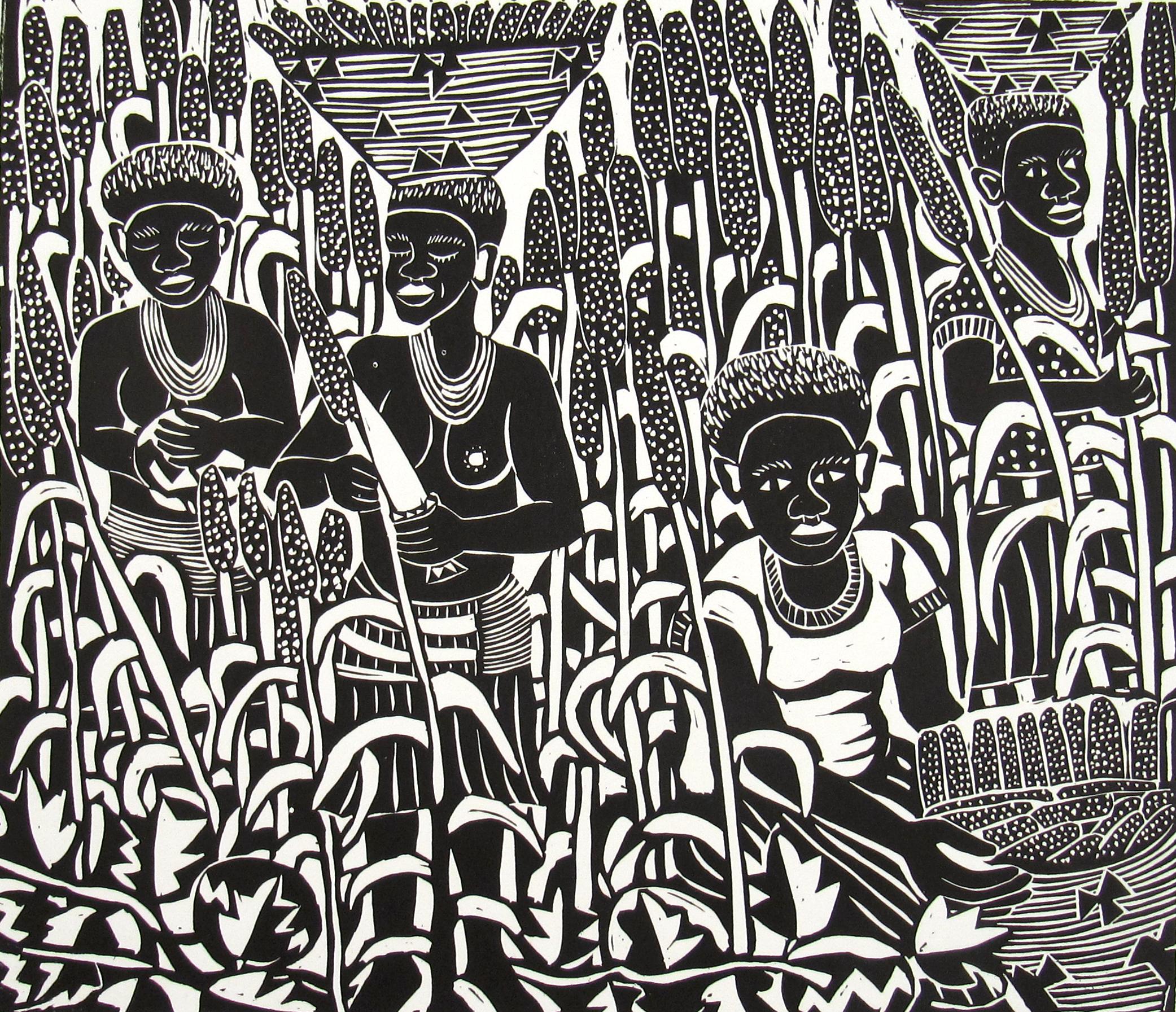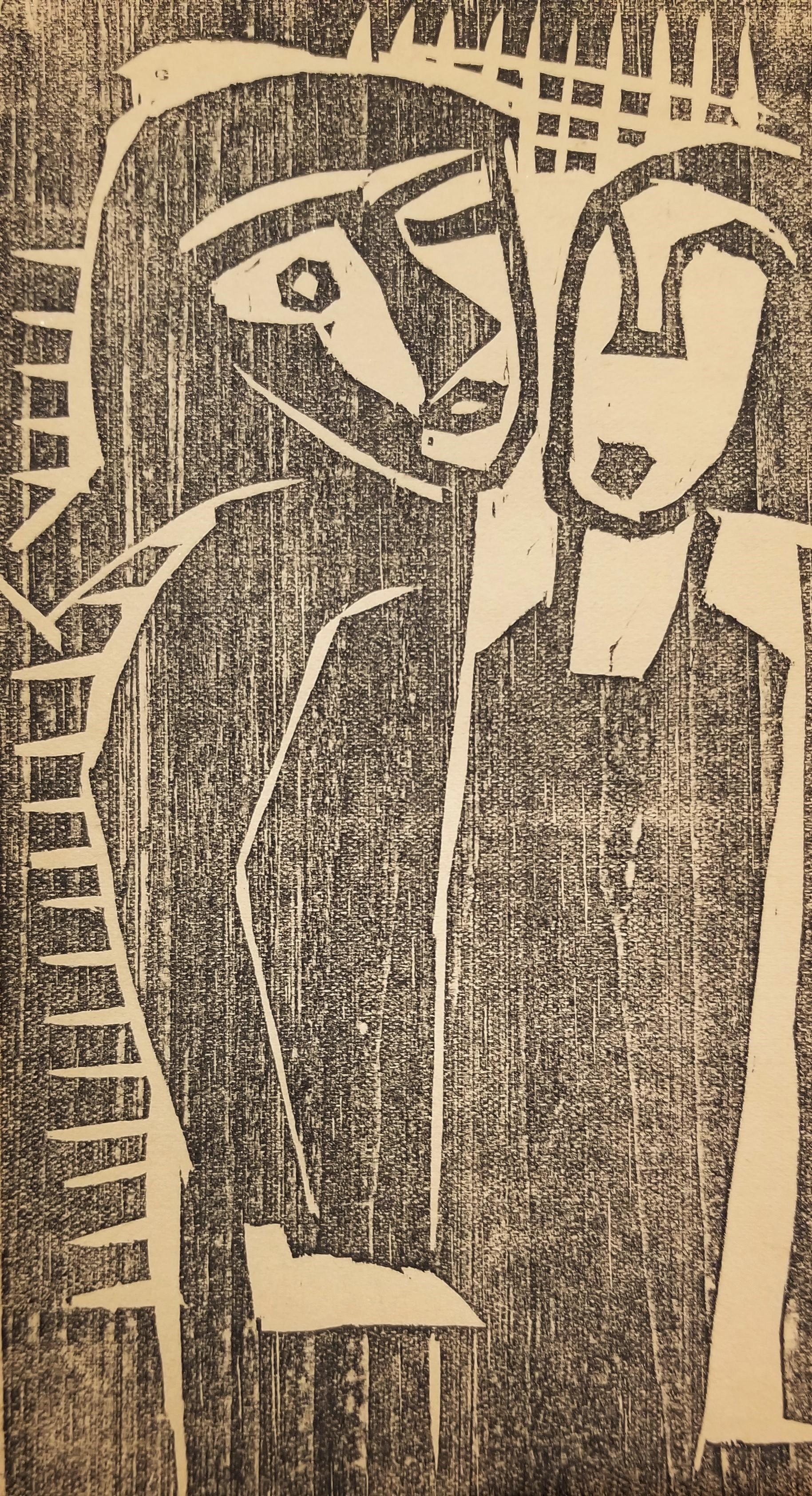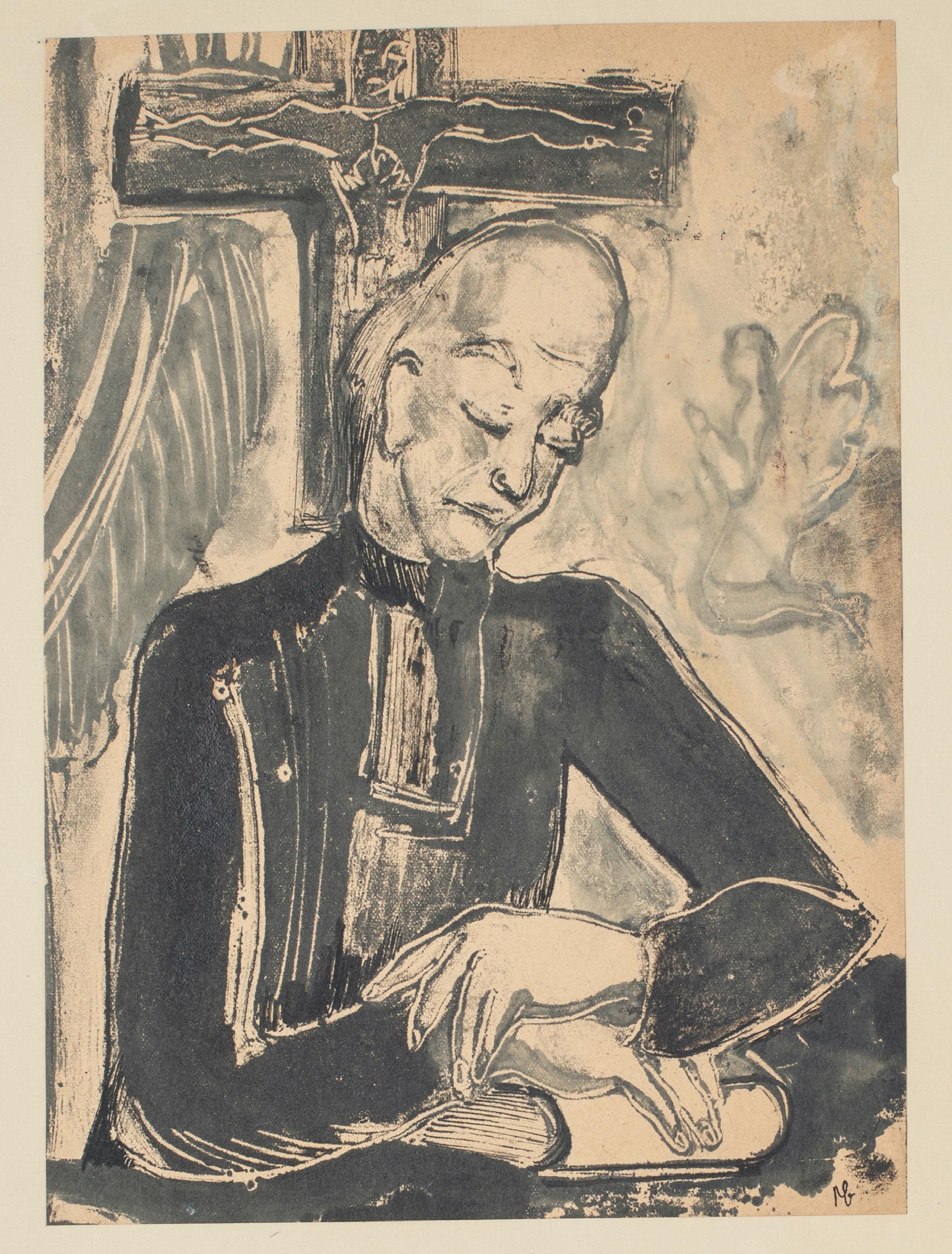Items Similar to 'Feast of Passover' — American Expressionism
Want more images or videos?
Request additional images or videos from the seller
1 of 3
Max Weber'Feast of Passover' — American Expressionism1920
1920
About the Item
Max Weber, Untitled 'Feast of Passover', woodcut, 1920, edition proofs—this impression from the edition of 25 printed in 1956, Rubenstein 30. Signed in pencil. A fine impression, on cream Japan paper; the full sheet with wide margins (1 1/2 to 4 1/4 inches), in excellent condition. Image size 5 x 5 15/16 inches (127 x151 mm); sheet size 12 1/2 x 9 inches (318 x 229 mm). Scarce. Matted to museum standards, unframed.
Printed, at the artist’s request, by Joseph Blumenthal, The Spiral Press, New York. Included in the suite 'FIVE PRINTS BY MAX WEBER' published by Erhard Weyhe, director of Weyhe Gallery Inc., the renowned New York gallery established in 1919 to specialize in fine prints.
Collections: Detroit Institute of Arts, National Gallery of Art, Los Angeles County Museum of Art, Museum of Modern Art, Philadelphia Museum of Art, Smithsonian American Art Museum.
ABOUT MAX WEBER'S RELIEF PRINTS
"In summary, Weber’s relief prints cannot be called just primitives or cubist forms. No single stylistic term is a satisfactory label. Collectively they suggest some common denominators: independence from academic traditions, interest in the element of design rather optical realism, simplicity and unpretentiousness in execution, craftlike tradition underlying their formulation and the desire to eschew the exactitude and dryness of wood engraving for the imprecision and painterly of hand-blocked work. The work was not a conscious effort at naiveté or lack of sophistication; on the contrary, it was an attempt to approach the origins of art.
ABOUT THE ARTIST
"To fill eternity with the ripest and the sanest expression of our consciousness is the essence as well as the purpose of life.” —Max Weber
Max Weber (1881-1961) was born in Bialystok, western Russia. When he was ten, his family came to America, settling in Brooklyn. While enrolled at nearby Pratt Institute from 1898 to 1900, he was a student of the modernist artist and influential teacher Arthur Wesley Dow who advocated for art as self-expression rather than traditional ornament.
Weber became an art teacher, first in the public schools in Lynchburg, Virginia, and beginning in 1903 at the Minnesota Normal School in Duluth. Inspired by Dow’s experience, Weber longed to continue his studies in Europe, and after years of prudent saving, he traveled to Paris in 1905.
He became a devoted disciple of Paul Cézanne, and met Guillaume Apollinaire, Robert Delaunay, Pablo Picasso, and Leo and Gertrude Stein. He became close friends with Henri Rousseau, later organizing the first exhibition of Rousseau’s work in the United States. A pupil of Matisse in 1908, he was deeply affected by the great artist’s expressive freedom and boldness of color. In recognition of his gifted assimilation of these many influences, one of Weber’s paintings was accepted for exhibition at the prestigious Salon d’Automne in 1907.
Weber returned to New York and had his first one-man show at the Haas Gallery in April of 1909, revealing himself as one of America’s earliest modernist artists. Although, as might have been expected, his cutting-edge work was mostly misunderstood and widely criticized, the show introduced the artist to Arthur B. Davies, who became a supporter and friend. Weber credited Davies with teaching him lithography in 1916, which enabled him to produce some of the earliest American modernist lithographs.
In 1919 Weber created his first group of woodcuts, many in color, which was exhibited in 1920 at the Montross Gallery in New York. Davies purchased some of the works, and the esteemed critic and gallery director Carl Zigrosser took other prints to sell at the Weyhe Gallery. That spring, ten of Weber’s poems with ten woodcuts were published in the Yiddish literary journal 'Schriften'. These early figurative abstractions display Weber’s unique melding of Cubist vernacular with primitivist sensibilities and stand among the most avant-garde American prints of the first quarter of the 20th century.
Weber’s subsequent relief prints represented Jewish themes, reflecting his heritage and spiritual convictions. Some of these works, such as ‘Feast of Passover’, expanded the artist’s repertoire to depict the interplay of multi-figure groupings. Weber’s prints were frequently reproduced in small literary magazines, and his book 'Primitives', published in 1926, integrated his poetry with his woodcuts.
Weber’s friendship with William Zorach, and an exhibition of the Provincetown printmakers in 1916, inspired his return to color relief prints. During 1919 and 1920, Weber created some thirty block prints—distinguished by their original use of color applied in a painterly manner, each impression being virtually unique.
In 1925 the artist taught at the Art Students League, New York. From 1928 to 1933, he produced thirty-four black ink lithographs printed from zinc plates. Many of these works demonstrated Weber’s continuing interest in using figurative groupings to explore his Zen-like approach to what he described as “the problem of form, balance of volume and sculpturesque spacial values.”
In 1930 Weber began to receive institutional recognition for his innovative work. That year, the Museum of Modern Art mounted a retrospective exhibition of his work, and four years later, the Metropolitan Museum of Art in New York purchased a painting. This interest was sustained through several important exhibitions in the 1940s and 1950s.
Today Weber's work is included in every major American art museum, including The Art Institute of Chicago; Cleveland Museum of Art; Detroit Institute of Arts; Los Angeles County Museum of Art; Metropolitan Museum of Art; Museum of Fine Arts, Boston; Museum of Modern Art; National Gallery of Art; Philadelphia Museum of Art; Smithsonian American Art Museum; Solomon R. Guggenheim Museum; and Whitney Museum of American Art.
- Creator:Max Weber (1881-1961, American)
- Creation Year:1920
- Dimensions:Height: 5 in (12.7 cm)Width: 5.94 in (15.09 cm)
- Medium:
- Movement & Style:
- Period:
- Condition:
- Gallery Location:Myrtle Beach, SC
- Reference Number:
About the Seller
5.0
Recognized Seller
These prestigious sellers are industry leaders and represent the highest echelon for item quality and design.
Platinum Seller
These expertly vetted sellers are 1stDibs' most experienced sellers and are rated highest by our customers.
Established in 1995
1stDibs seller since 2016
256 sales on 1stDibs
Typical response time: 1 hour
Associations
International Fine Print Dealers Association
- ShippingRetrieving quote...Ships From: Myrtle Beach, SC
- Return PolicyA return for this item may be initiated within 7 days of delivery.
More From This SellerView All
- 'Theater' — 1920s German ExpressionismLocated in Myrtle Beach, SCA German Expressionist woodcut, with original hand-coloring in watercolor, depicting a parent and child watching a theatrical production; ...Category
1920s Expressionist Figurative Prints
MaterialsWoodcut
- 'Court' — 1930s Social Conscience, WPA Woman ArtistLocated in Myrtle Beach, SCClaire Mahl Moore, 'Court' also 'The Authorities', woodcut, 1936, edition 5. Signed 'Mahl' and titled in pencil. A fine, richly-inked impression, on ...Category
1930s Expressionist Figurative Prints
MaterialsWoodcut
- Der Hirte (The Shepherd) — original hand-coloringLocated in Myrtle Beach, SCRichard Seewald, 'Der Hirte (The Shepherd)', woodcut with hand coloring, c. 1919. Unsigned as published in 'Genius', Vol 1, no. 1, 1919. A fine, richly...Category
1910s Expressionist Figurative Prints
MaterialsWoodcut
- 'Mehr Sonne fur 1924' (More Sun for 1924)— 1920s German ExpressionismBy Karl MichelLocated in Myrtle Beach, SCKarl Michel, 'Mehr Sonne fur 1924. Viel Gluck Wunscht Karl Michel U. Frau', woodcut, 1924, edition 20. Signed, dated, and numbered 'op. 162' and '15/20' in pencil. Signed in the image, lower left. A fine, richly-inked impression on buff wove paper, with full margins (1 1/2 to 2 3/4 inches), in very good condition. Printed by the artist. Scarce. Matted to museum standards, unframed. New Year's Greeting – English translation: "More Sun for 1924. Good Luck Wishes from Karl Michel and his Wife." Image size 4 5/8 x 4 3/4 inches (118 x 121 mm); sheet size 7 3/4 x 10 inches (198 x 254 mm). ABOUT THE ARTIST Karl Michel (1889-1984) was a noted graphic designer and expressionist printmaker during Germany's pre-Nazi Weimar Republic (1919-1933). Michel’s work was the subject of a feature article in the influential German graphic design magazine Das Plakat...Category
1920s Expressionist Figurative Prints
MaterialsWoodcut
- 'Der Gartner' (The Gardener) — 1920s German ExpressionismBy Karl MichelLocated in Myrtle Beach, SCKarl Michel, 'Der Gartner' (The Gardener), woodcut, c. 1925. Signed, titled, and numbered '15/50' in pencil. Signed in the block, lower left and right. A fine, richly-inked impression on buff wove paper, with full margins (1 1/2 to 2 3/4 inches), in excellent condition. Matted to museum standards, unframed. Scarce. Image size 5 1/4 x 3 7/8 inches (133 x 98 mm); sheet size 10 x 7 3/4 inches (254 x 198 mm). ABOUT THE ARTIST Karl Michel (1889-1984) was a noted graphic designer and expressionist printmaker during Germany's pre-Nazi Weimar Republic (1919 - 1933). Michel’s work was the subject of a feature article in the influential German graphic design magazine 'Das Plakat...Category
1920s Expressionist Figurative Prints
MaterialsWoodcut
- 'Venus' — 1920s German ExpressionismBy Karl MichelLocated in Myrtle Beach, SCKarl Michel, 'Venus, Ex Libris - Hanns U. Herta Heeren', woodcut, 1923, edition not stated but small. Signed, dated, and numbered 'op.154' in pencil. Signed in the block, lower left. A fine impression, on cream Japan paper, with full margins (15/16 to 2 11/16 inches), in good condition. Printed by the artist. Matted to museum standards (unframed). . Translation: Venus Ex Libris for Hanns and Herta Heeren. Image size 5 15/16 x 4 inches (156 x 102 mm); sheet size 9 5/8 x 6 inches (245 x 152 mm). ABOUT THE ARTIST Karl Michel (1889-1984) was a noted graphic designer and expressionist printmaker during Germany's pre-Nazi Weimar Republic (1919-1933). Michel’s work was the subject of a feature article in the influential German graphic design magazine Das Plakat (The Poster) in 1920. An anti-war advocate, Michel created a suite of 12 wood engravings depicting his impressions of the humanitarian toll of WWII entitled ‘Humanitas’ (Humanity). The German publishing house Greifenverlag published the series in a reduced folio of unsigned prints. Michel’s graphic work is held in the permanent collections of the Auckland War Memorial Museum (New Zealand), Frederikshavn Kunstmuseum & Exlibrissamling (Denmark), Museum of Applied Arts (Budapest), The Robert Gore Rifkind Center for German Expressionist Studies at the Los Angeles County Museum of Art, and the German Expressionism...Category
1920s Expressionist Figurative Prints
MaterialsWoodcut
You May Also Like
- Elia Shiwoohamba ( Namibia, 1981 ) Harvesting Time Lino Cut African School 2006By Elia ShiwoohamaLocated in Meinisberg, CHElia Shiwoohamba (* 1981 , Windhoek, Namibia ) Harvesting Time • African School • Linoleum cut • Sheet ca. 34.5 x 43 cm (Image is smaller) • Bottom left numbered 8/50 and titled • ...Category
Early 2000s Expressionist Landscape Prints
MaterialsPaper, Linocut, Woodcut
- By the Nets Bei den NetzenBy Karl Schmidt-RottluffLocated in London, GBKARL SCHMIDT-ROTTLUFF 1884-1976 Rottluff, Germany 1884 - 1976 Berlin (German) Title: By the Nets Bei den Netzen, 1914 Technique: Original hand signed woodcut on laid paper ...Category
1910s Expressionist Figurative Prints
MaterialsWoodcut
- On the Quay Wall Auf der Quaimauer, 1921By Lyonel FeiningerLocated in London, GBLYONEL FEININGER 1871-1956 1871 - New York - 1956 (American/German) Title: On the Quay Wall Auf der Quaimauer, 1921 Technique: Original Hand Signed Woodcut on Wove Paper Paper...Category
1920s Expressionist Figurative Prints
MaterialsWoodcut
- Zwei Frauen (Two Women) /// German Expressionism Karl Schmidt-Rottluff WoodcutBy Karl Schmidt-RottluffLocated in Saint Augustine, FLArtist: Karl Schmidt-Rottluff (German, 1884-1976) Title: "Zwei Frauen (Two Women)" Portfolio: Das Spiel Christa vom Schmerz der Schönheit des Weibes (The Play Christa from the Pain o...Category
1910s Expressionist Figurative Prints
MaterialsEngraving, Woodcut
- Men - Pair of Original Monotype Woodcuts - Mid 1900Located in Roma, ITMen is a pair of two original monotype woodcuts realized by an Anonymous artist of the XX century, in 1950 ca, glued on paper. In very good condition. Image dimension : 26 x 19.5 c...Category
Mid-20th Century Expressionist Portrait Prints
MaterialsWoodcut
- My WorkBy Joan SnyderLocated in New York, NYJoan Snyder has been called an autobiographical, even confessional artist, who draws from her experiences and surroundings to create her paintings. While her subjects vary widely, Sn...Category
1990s Expressionist Figurative Prints
MaterialsEtching, Woodcut
Recently Viewed
View AllMore Ways To Browse
Early American Primitive
Early American Art Primitive
Wood Block Prints Japan
Black And White Wood Block
Japanese Wood Relief
Boston Web
Picasso Black And White Lithograph
Picasso Lithographs Black And White
Matisse Lithography
Grouping Of Five
William Weber
B And Stein
Jewish Woodcut
Pablo Picasso Lithograph Black And White
Matisse Lithograph Black And White
1950s Eternity
Cubist Lithograph 1950s
Henri Matisse Hand Signed Lithograph





